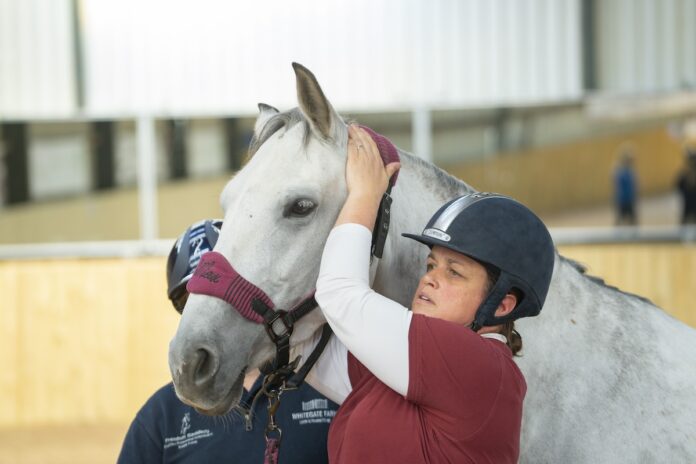Essential bridle fitting anatomy: the hyoid apparatus
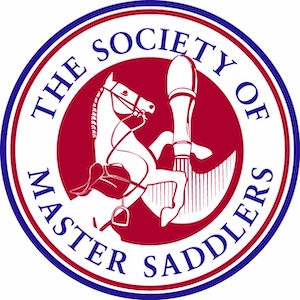
Saddle and bridle fitters who read the feature and complete the task (see ‘How to gain your CPD’ below the quiz) will receive CPD recognition from the Society of Master Saddlers (SMS). SMS Registered Qualified Saddle and Bridle Fitters are required to maintain CPD fulfilment as part of their registration.
For many years, riders have been fairly ignorant about the influence that a bridle can have on the horse. The current interest in bit and bridle fitting is helping to educate riders, which is great news for our equine friends.
But do riders really understand why bit and bridle fitting is so important? Or how it influences their horses? As an SMS Qualified Bridle Fitter, you should be able to explain why. Here, Catherine Baker looks at the anatomical connections between the head and the rest of the horse’s body.
Most horses are ridden with a bit, the purpose of which is to communicate our thoughts or intentions to the horse via the reins.
The bit achieves this by applying direct pressure on various parts of the horse’s mouth and indirect pressure through the bridle on the head.
The amount of pressure depends greatly upon the type of bit and bridle used and, of course, the understanding and ability of the rider holding the reins. When the rider is knowledgeable and competent, they can affect the way the horse uses its body and improve the horse’s movement.
The anatomical part key to this is the hyoid apparatus.
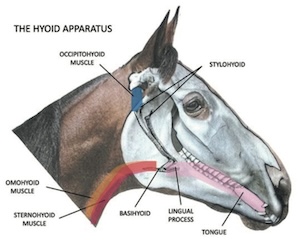
THE HYOID APPARATUS
Located at the base of the skull between the cheeks of the horse, the hyoid apparatus consists of a collection of small bones which form the shape of the letter Y and connect directly to the sternum, scapula and poll via muscular attachments.
The lower part of the hyoid apparatus is the basihyoid - the insertion point for the sternohyoid and omohyoid muscles.
THE VENTRAL CHAIN
The ventral chain runs along the ventral, or underside, of the horse. It begins with the sternohyoid and sternothyroid muscles which connect the hyoid to the sternum or chest bone. This connection then carries on through the pectoral muscles and along the abdominal muscles running along the belly (ventral aspect) and up into the horse’s pelvis.
Also forming part of the ventral chain are the omohyoid and omothyroid muscles which connect the hyoid to the scapula (omohyoid) and forelimbs (omothyroid) via fascia. From here, they link into the fascia chain which runs from the head along the underside of the neck, the inside of the shoulder and through to the hindlimb, ending at the toe.
Put simply, the ventral chain connects the horse’s mouth to its shoulders, forelegs, trunk, pelvis and hindlegs and is key for lifting the forehand, supporting the posture of the back and lowering the hind end.
THE DORSAL CHAIN
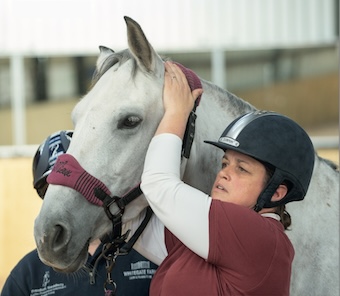
The dorsal chain runs along the dorsal or topside of the horse connecting the mouth with the poll, neck, back and hindquarters. The connection for this chain begins with the occiptohyoid muscle which connects the hyoid to the occiput or poll.
The nuchal ligament attaches to the back of the skull at the external occipital protuberance or nuchal crest, continuing the connection down the neck and along the dorsal muscle chain, through the back and into the hindquarters. This chain is largely responsible for forward propulsion.
THE TONGUE
We’ve spoken about the connections from the hyoid that run back through the body; but there is one that runs forwards - and that is the tongue.
The forward-most bone of the hyoid apparatus is the lingual process which is embedded into the root of the tongue. For the horse to remain relaxed in its movement, to be able to engage the back and hindquarters and maintain the freedom to use itself correctly in extended and lateral work, the horse must be comfortable in his mouth.
The tongue is an extremely sensitive, large, muscular organ which usually fills the whole of the oral cavity. It varies in size from horse to horse and can be thick and fleshy, which is typical of native breeds and cob types, or fairly thin which is more typical of Thoroughbreds.
Its primary function is to aid eating, from selecting the food, moving it back to the cheek teeth and on to the oesophagus; but it also serves as a cushion for the sensitive bars and it is how many riders communicate with their horse.
HOW CAN BIT AND BRIDLE AFFECT COMFORT AND PERFORMANCE?
We have established that the hyoid is connected to the tongue, scapula, sternum and poll as well as indirectly connected to the trunk and hindquarters.
If the bit or bridle is not comfortable for the horse, they will often use their tongue to try to alleviate the discomfort. This results in tension in the tongue which can then be transferred to the hyoid.
Any discomfort, pain or restriction on the hyoid can have a direct impact upon the horse’s ability to use itself effectively and efficiently. Therefore it is imperative that any bit or bridle used on the horse is suitable and fitted correctly.
Key points
- The bridle must suit the head conformation of the horse and be the correct size. It should avoid any sensitive areas such as around the ears, the TMJ [temporomandibular joint] and where any blood vessels or nerves may lie.
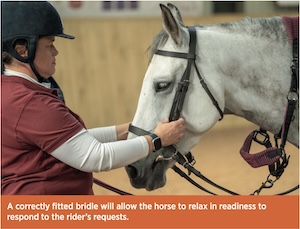
- The noseband must be fitted at the correct height and with two fingers between the noseband and the nasal bone on the front of the face. A noseband which is incorrectly fitted can cause pain and discomfort in the mouth or restrict the horse’s ability to chew and swallow.
- The bit must be fitted at the correct height and be the correct length for the horse. The height should not be determined by the number of wrinkles in the lips but by looking in the mouth and seeing where the mouthpiece sits in relation to the mouth conformation.
- The length of the mouthpiece should be wide enough so that it does not pinch the cheeks or restrict the tongue, but not so wide that it hangs low in the mouth.
- The mouthpiece must be one which the horse can relax into. We want the horse to seek the contact, not be afraid to take it.
- Finally, the rider must have the skill and understanding to be able to convey their intentions clearly and kindly.










